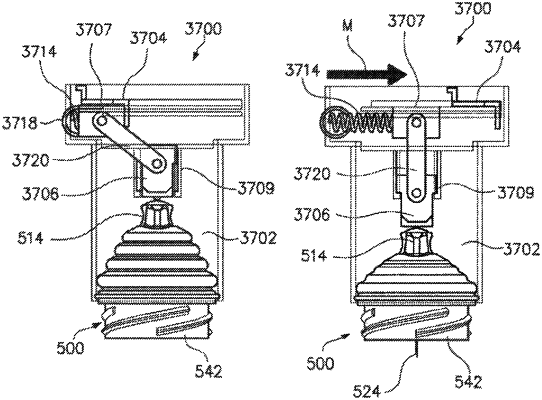| CPC A61B 5/1411 (2013.01) [A61B 5/14503 (2013.01); A61B 5/14532 (2013.01); A61B 5/14542 (2013.01); A61B 5/14546 (2013.01); A61B 5/150259 (2013.01); A61B 5/150282 (2013.01); A61B 5/150396 (2013.01); A61B 5/150419 (2013.01); A61B 5/150427 (2013.01); A61B 5/150511 (2013.01); A61B 5/15087 (2013.01); A61B 5/15107 (2013.01); A61B 5/15113 (2013.01); A61B 5/15117 (2013.01); A61B 5/1513 (2013.01); A61B 5/15186 (2013.01); A61B 5/1519 (2013.01); A61B 5/15194 (2013.01); A61B 5/157 (2013.01); A61B 5/6865 (2013.01); A61M 5/158 (2013.01)] |

| AS A RESULT OF REEXAMINATION, IT HAS BEEN DETERMINED THAT: |
| The patentability of claims 1 and 10 is confirmed. |
| Claims 2-9 and 11-28 were not reexamined. |
|
1. An insertion assembly for inserting a glucose sensor into a subject, the insertion assembly comprising:
the glucose sensor, wherein a distal end of the glucose sensor is configured to be inserted under skin of the subject;
a distal surface including an adhesive layer, wherein the distal surface is configured to be positioned on the skin of the subject such that the adhesive layer adheres to the skin of the subject;
an interior of the insertion assembly including a first spring in a loaded position, a second spring, a sliding member, an actuator, and a straight track having a length, wherein the sliding member is configured to move only within the straight track; and
a button configured to be pressed along a first axis toward the interior of the insertion assembly,
wherein the button is further configured to release the first spring from the loaded position upon being pressed, such that the first spring causes the sliding member to move within the straight track along a second axis different from the first axis, wherein the second axis is defined by the length of the straight track,
wherein movement of the sliding member within the straight track causes the actuator to advance in a distal direction along an insertion axis different from the first axis and second axis, wherein advancement of the actuator causes advancement of a sharp and the glucose sensor in the distal direction along the insertion axis such that the distal end of the glucose sensor is inserted under the skin of the subject,
wherein the sliding member is further configured to apply a force on the actuator in a proximal direction along the insertion axis after the sharp and the glucose sensor have been advanced in the distal direction along the insertion axis,
wherein the second spring is configured to expand and retract the sharp in the proximal direction along the insertion axis while the distal end of the glucose sensor remains under the skin of the subject,
wherein the second spring is a compression spring, and
wherein the glucose sensor is configured to operate for a period of about seven days or more.
|